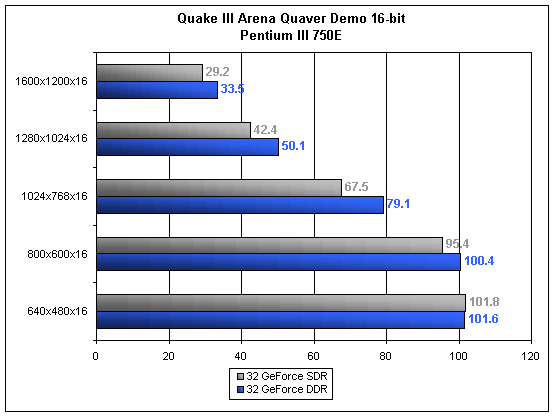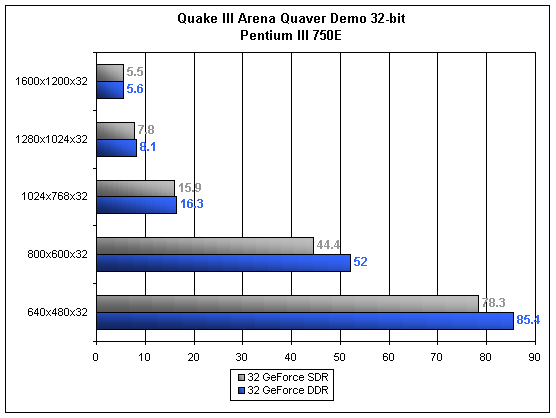Performance of Quaver on SDR/DDR
Any attempt to substantially push a video card to its limits using the built in Quake III Arena demos is almost impossible. The level is not only low on the texture front, it also does not contain as many rooms as other levels. Resolutions and colors where the demo plays flawlessly are often too high to play the game in full with. In order to fully test how memory bandwidth and RAM size affects video card performance, a separate and more stressful benchmark is needed. For the purposes of this test, we turned to Anthony "Reverend" Tan's Quaver benchmarking demo. It was a well known fact that some levels of Quake III Arena push video cards harder than others. The most notorious of these levels is the Q3DM9 map, with a reported 30 plus megabytes of textures. Tests were performed on our Pentium III 750E system (see The Test section for more details) with Quake III Arena settings at 'normal' except for one aspect: the texture detail slider was set all the way to the right, ensuring that the maximum textures were being processed and stressing the system. Let's take a look at how 32MB SDR and DDR cards react to such a stressful environment.


As can be seen in the above graphs, the difference in speed when at 16-bit is what we would expect. By having a higher peak bandwidth value, the DDR GeForce is able to accept information into and out of the RAM at a faster rate than the SDR card can. The speed differences between the DDR GeForce and the SDR GeForce when at 32-bit color mode are the intriguing numbers. The difference in speed begins at what we would expect, with the DDR GeForce beating the SDR. However, as the resolutions get higher, not only does the frame rate begin to crawl but the difference between the DDR and SDR cards becomes almost nonexistent. To what do we owe such an interesting outcome? The answer is RAM.
Before we discussed the limitations of memory bandwidth on a cards performance, but we assumed that the amount of memory on the video card was sufficient to support the data being passed to the RAM via the processor. This assumption neglected to take into account what happens when the RAM on the video card becomes saturated with data and the GPU still needs to pass more information into it before the scene can be successfully rendered. What happens in this stage, when the RAM on the video card becomes saturated and more data still needs to be passed to it, is what is called texture swapping. The next section deals with what texture swapping is and why it is such a hindrance on smooth game play.










1 Comments
View All Comments
Dr AB - Friday, May 8, 2020 - link
Woww what an amazing article! There were a lot of things that I didnt even knew glad that I read it. Its fascinating how things have progressed in 20 years.